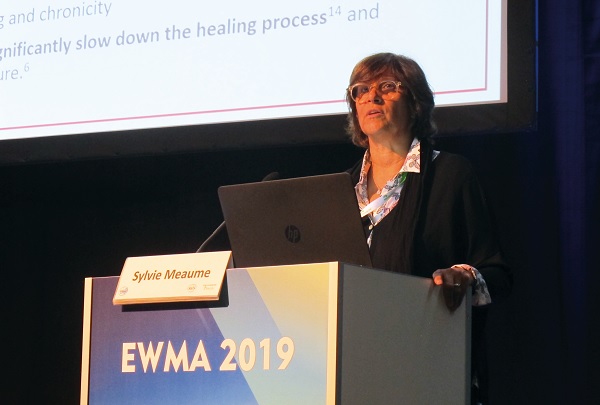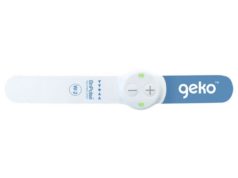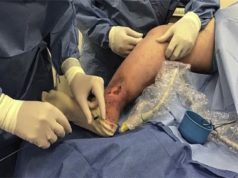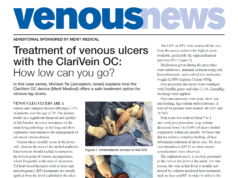
Results from two open prospective trials have revealed that TLC-NOSF sucrose octasulphate dressing, with poly-absorbent fibres, represents an effective and safe treatment for the local management of leg ulcers. In addition, cost-effectiveness studies examining the economic impact of the dressing have demonstrated that significant annual cost savings can be achieved with TLC-NOSF sucrose octasulphate dressings.
Sylvie Meaume (Hopital Rotschild, Paris, France) presented the findings of the NEREIDES and CASSIOPEE multicentre trials at the European Wound Management Association’s (EWMA) 29th conference (5–7 June, Gothenburg, Sweden). She said: “It is difficult to treat these wounds and 40–50% of venous leg ulcers remain unhealed after 12 months. Also, the problem of recurrence is a major issue, with there being more than a 70% recurrence rate within three months.”
An effective treatment of leg ulcers
The NEREIDES and CASSIOPEE trials aim to assess the efficacy and safety of the TLC-NOSF dressing (Urgo Medical) in the local management of leg ulcers at different stages of the healing process, and are being conducted across a total of 35 centres, hospitals and private practices in France. Patients with non-infected, moderately to heavily exudative leg ulcers—either of venous or mixed aetiology—were treated with the dressing and appropriate compression therapy over the course of 12 weeks.
Thirty-seven patients with wounds in the desloughing stage (70% or more sloughy tissue) entered into the NEREIDES trial, while 51 with wounds in the granulating stage (50% or more granulation tissue) were part of the CASSIOPEE study.
Other than the percentage of sloughy tissue on wound bed at baseline, the cohorts of both studies were very similar and consisted of 90% or more outpatients that were predominantly female and had an average age of over 75 years. In addition to this, a majority of the patients in both NEREIDES and CASSIOPEE had a marked history of suffering with venous ulcers.
Regarding the characteristics of the patients’ wounds, Meaume said: “If we look at the wound, it is a very similar duration and area. Half of the wounds have a duration of more than six months despite previous compression therapy, and a third of the wounds have an area of more than 10cm³. It is important to notice that it is not just simple wounds, there are arterial wounds included in the study.”
After 12 weeks of treatment, the relative wound area reduction (RAWR) measured in both trials presented a beneficial outcome, with patients in the NEREIDES study experiencing a 60% reduction compared to an 81% RAWR in the CASSIOPEE trial. A wound closure rate of 18% was recorded for ulcers treated with the dressing as part of NEREIDES, and 20% for wounds in CASSIOPEE.
Wound healing outcomes depending on wound duration at initiation were also revealed, and Meaume described these findings as “the major result of these studies”. In the NEREIDES study, RAWR for wounds with a duration of less than six months was 85%, whereas wounds with a duration of six months or more had a reduction rate of 43%. These results were consistent with the wound closure rate measured in the CASSIOPEE test, with 30% of ulcers less than six months old closing compared to just 11% of wounds six months or older. “The conclusion of these two studies is that you can use this dressing, and the sooner is better,” said Meaume.
In terms of safety, the dressing was well tolerated in all healing stages; a total of 19 adverse events—none of which were serious—were recorded throughout both studies.
Meaume concluded: “This result corroborates the findings of previous clinical trials on TLC-NOSF dressings and confirms the clinical interest of this new TLC-NOSF dressing with poly-absorbent fibres in the local treatment of exuding chronic wounds, at their different wound healing stages and until wound closure, in the accepted standard of wound care.”
Significant annual cost savings
Following the recent recommendation of the TLC-NOSF dressing by the UK National Institute for Health and Care Excellence (NICE), Isaac Odeyemi (Manchester, UK) also spoke at EWMA to present the results of two cost-effectiveness studies that were conducted across the healthcare systems of the UK and Germany.
Both studies involved a Markov-model cost-effectiveness design using four states of patient health, with a further distinction made between pre- and post-amputation wounds. Referring to the EXPLORER double-blind randomised controlled trial, which also demonstrated the safety and efficacy of the dressing, Odeyemi noted that the trial informed the model efficacy parameters of their analysis, supplemented by estimates from the literature. In models for the UK, the EXPLORER study’s endpoint of 20 weeks was extrapolated to a base-case time horizon of one year, which was further extended to 100 weeks in the German model.
Costs were analysed from individual countries’ perspectives and adjusted for 2017 prices. As reported by NICE in their recommendation for UrgoStart dressings, Odeyemi quoted an average cost-saving of “up to £5.4 million each year, if only 25% of people having treatment with diabetic foot ulcers in the UK use UrgoStart”.
In the UK, Odeyemi reported that the study demonstrated a cost saving of £342 per patient over one year, with a healing time reduced by “up to 60 days”. In the German study, the model demonstrated a lower cost per effectively treated bleed of €6,77.58 for the UrgoStart group, compared to €10,375.56 for the control group over the 100-week period.
Surprisingly, Odeyemi revealed that “sensitivity analyses also showed UrgoStart was dominant in terms of all the model input varied. […] You could give any other dressing in the healthcare system for free—and UrgoStart would still be cost-saving.” This is a rare result in a health economics analysis, emphasising that the dressing was economically dominant in both the UK and the German studies, both of which provided exactly the same result.
In conclusion, Odeyemi emphasised the importance of the finding: “This is actually quite significant—it is a lot of money that healthcare systems can actually save. The main cost driver was the efficacy of the TLC-NOSF compared to neutral advanced wound care dressings. Furthermore, earlier use of the dressing resulted in even better efficacy, higher cost savings and better quality of life.”












